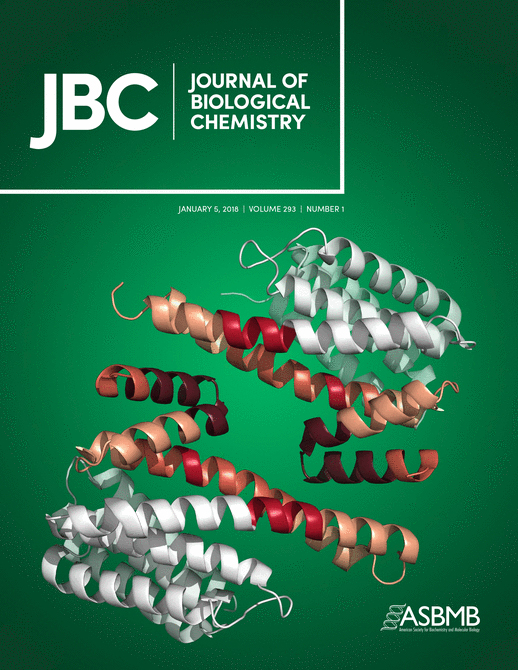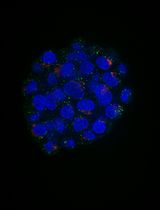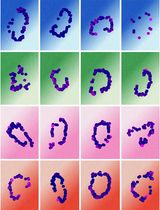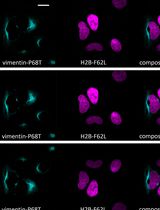- EN - English
- CN - 中文
Quantitative Analysis of Cargo Density in Single-extracellular Vesicles by Imaging
成像技术定量分析单细胞外囊泡中内容物的密度
发布: 2018年12月20日第8卷第24期 DOI: 10.21769/BioProtoc.3111 浏览次数: 5869
评审: Yanjie LiLuis Alberto Sánchez VargasNaresh Kasoju
Abstract
Function of extracellular vesicles such as exosomes and microvesicles is determined by their wide ranges of cargoes inside them. Even in the pure exosomes or microvesicles the cargo contents are very heterogeneous. To understand this heterogeneous nature of extracellular vesicles, we need information of the vesicles, which will give us some parameters including vesicle size, number and cargo content of each vesicle. Here, we describe a new method to quantify cargo density in single-extracellular vesicles. Staining of extracellular vesicles in a membrane lipid content-proportionate manner and immobilization of extracellular vesicles onto glass substrate allow us to obtain cargo density information of single-extracellular vesicles. This protocol will be useful to analyze the effects of various drugs or genetic manipulation on vesicle generation and maturation including cargo sorting into heterogeneous extracellular vesicles.
Keywords: Extracellular vesicle (细胞外囊泡)Background
Extracellular vesicles are small membrane-bound vesicles released from a variety of cells, comprising exosomes and microvesicles based on the current knowledge of their biogenesis (van Niel et al., 2018). Extracellular vesicles contain various kinds of cargoes including cytosolic proteins, membrane proteins, lipids, microRNAs, and mRNAs. The cargoes are highly heterogeneous in their contents and variety depending on cell types. Extracellular vesicles play a role in erythrocyte maturation, antigen presentation, tumor metastasis, or prion disease and Alzheimer’s disease propagation, through cell-to-cell communication by carrying their cargoes from the donor to the recipient cells (Maas et al., 2017).
Exosomes are formed by fusion of multivesicular endosomes (MVEs) with the plasma membranes. On the other hand, microvesicles are formed by shedding of the plasma membranes. Endosomal sorting complexes required for transport (ESCRT) is known to be critical for the generation of lysosomal MVEs. It is reported that ceramide is important for the generation of exosomal MVEs (Trajkovic et al., 2008). The size of exosomes ranges from 30 nm to 100 nm, whereas that of microvesicles is from 50 nm to 1,000 nm (Karpman et al., 2017; van Niel et al., 2018). The mechanism of cargo sorting into extracellular vesicles, especially microvesicles, is still mysterious. For understanding the heterogeneous nature of extracellular vesicles, it is important to get more information on cargo density as well as the number and the size of single extracellular vesicles.
Conventionally, we can quantitate the amount of cargo in total extracellular vesicles obtained from culture media using western blot analysis. Since extracellular vesicles are highly heterogeneous as mentioned above, we need to get more precise figures of extracellular vesicles for the understanding of vesicle generation and maturation including the cargo sorting. We can solve this issue with detecting “cargo density of single-extracellular vesicles”. Here, we provide details on our new method for getting information of each extracellular vesicle with a cargo density. This protocol provides a useful readout of cargo content in each extracellular vesicle, and promote to unravel detailed molecular mechanism of the cargo sorting and accelerate clinical application of extracellular vesicles.
Materials and Reagents
- 10 μl, 200 μl, or 1,000 μl tips (Fukae-Kasei, Watson, catalog numbers: 123R-254CS, 123R-755CS, 110-706C)
- 200 μl gel loading tips (Quality Scientific Plastics, catalog number: 010-Q)
- 5 ml or 10 ml pipettes (Corning, catalog numbers: 4487, 4488)
- 50 ml conical centrifuge tubes (BD, Falcon, catalog number: 352070)
- 1.5 ml microcentrifuge tubes (Ina Optika, BIO-BIK, catalog number: CF-0150)
- 35 mm or 100 mm culture dish (Corning, catalog numbers: 430165, 430167)
- 6-well plate (Corning, catalog number: 3516)
- 35 mm glass bottom culture dish (MatTek, catalog number: P35G-0-14-C)
- 0.22 μm syringe filters (Millipore, catalog number: SLGVJ13SL)
- Kimwipes (Nippon Paper Crecias, catalog number: 62011)
- Aluminum foil (Mitsubishi Aluminum, Nippaku foil)
- Ultracentrifuge thick wall polycarbonate tubes (Beckman Coulter, catalog number: 349622)
- HeLa cells (RIKEN cell bank, catalog number: RCB0007)
- MDA-MB-231 cells (ATCC, catalog number: HTB-26)
- Dulbecco's modified Eagle medium (DMEM), high glucose, with L-Glutamine and Phenol Red (FUJIFILM Wako Pure Chemical, catalog number: 044-29765)
- Fetal bovine serum (FBS) (Biowest, catalog number: S1820)
- Penicillin-streptomycin Mixed Solution (P/S) (NACALAI TESQUE, catalog number: 09367-34)
- Trypsin-EDTA solution with phenol red (NACALAI TESQUE, catalog number: 32778-34)
- FuGENE HD transfection reagent (Promega, catalog number: E2311)
- Opti-MEM, reduced serum medium (Thermo Fisher Scientific, InvitrogenTM, catalog number: 31985070)
- Extracellular vesicles-free fetal bovine serum (Thermo Fisher Scientific, GibcoTM, catalog number: A2720803)
- Total exosome isolation reagent (from cell culture media) (Thermo Fisher Scientific, InvitrogenTM, catalog number: 4478359)
- Paraformaldehyde (PFA) powder (Sigma-Aldrich, catalog number: P6148)
- Normal goat serum (Jackson Immuno Research, catalog number: 005-000-121)
- Lipophilic Tracer, DiD (Ex. 644 nm; Em. 665 nm) (Thermo Fisher Scientific, InvitrogenTM, catalog number: D7757)
- Biotinyl Cap PE (PE-biotin) (Avanti Polar Lipids, catalog number: 870277)
- Biotin-conjugated bovine serum albumin (BSA-biotin) (Sigma-Aldrich, catalog number: A8549)
- Bovine serum albumin (BSA) (Sigma-Aldrich, catalog number: A8022)
- Streptavidin (Thermo Fisher Scientific, Invitrogen, catalog number: 434301)
- Antibody of cargo (e.g., anti-cMET antibody; Cell Signaling, catalog number: 3127S)
- Secondary antibody (e.g., anti-mouse IgG Alexa Fluor 594; Cell Signaling, catalog number: 8890S)
- Plasmid DNA of cargo (e.g., constructing plasmid DNA of GFP- or mCherry-fused cargo protein)
- Sodium chloride (NaCl) (NACALAI TESQUE, catalog number: 31319-45)
- Potassium chloride (KCl) (Wako, catalog number: 163-03545)
- di-Sodium hydrogenphosphate (Na2HPO4) (NACALAI TESQUE, catalog number: 31723-35)
- Potassium dihydrogenphosphate (KH2PO4) (NACALAI TESQUE, catalog number: 28721-55)
- NaOH (NACALAI TESQUE, catalog number: 31511-05)
- Phosphate-buffered saline (PBS) (see Recipes)
- 4% PFA (see Recipes)
Equipment
- Glass vial (Maruemu, catalog number: 5-115-02)
- Forceps
- Pipettes (Gilson, models: PIPETMAN P10, P20, P200, P1000)
- Pipetter (Drummond Scientific, model: Pipet-Aid XP)
- Polypropylene microtube storage rack, 80 positions
- Test tube rack (Sanwakaken, catalog number: SS30-10)
- Clean hood (NK System, model: VH-1300BH-2A)
- CO2 incubator (Forma Scientific, model: 3158)
- Confocal laser scanning microscope (Zeiss, model: LSM 510 Meta)
- Transmitted Light Microscope (Olympus, model: IMT-2)
- Ultracentrifuge (Beckman Coulter, model: Optima TL)
- Ultracentrifuge rotor (Beckman Coulter, model: TLA-100.3)
- Refrigerated microcentrifuge (Tomy Seiko, model: MRX-151)
- Vortex mixer (Scientific Industries, model: Vortex-Genie 2)
- Refrigerator, 4 °C
- Freezer, -20 °C
- Cold room, 4 °C
Software
- LSM510 v4.2 operating software (Zeiss)
- ImageJ (https://imagej.nih.gov/ij/)
- Excel for Mac 2011 (Microsoft)
Procedure
文章信息
版权信息
© 2018 The Authors; exclusive licensee Bio-protocol LLC.
如何引用
Readers should cite both the Bio-protocol article and the original research article where this protocol was used:
- Kajimoto, T. and Nakamura, S. (2018). Quantitative Analysis of Cargo Density in Single-extracellular Vesicles by Imaging. Bio-protocol 8(24): e3111. DOI: 10.21769/BioProtoc.3111.
- Kajimoto, T., Mohamed, N. N. I., Badawy, S. M. M., Matovelo, S. A., Hirase, M., Nakamura, S., Yoshida, D., Okada, T., Ijuin, T. and Nakamura, S. I. (2018). Involvement of Gbetagamma subunits of Gi protein coupled with S1P receptor on multivesicular endosomes in F-actin formation and cargo sorting into exosomes. J Biol Chem 293(1): 245-253.
分类
细胞生物学 > 细胞成像 > 荧光
细胞生物学 > 细胞器分离 > 胞外囊泡
您对这篇实验方法有问题吗?
在此处发布您的问题,我们将邀请本文作者来回答。同时,我们会将您的问题发布到Bio-protocol Exchange,以便寻求社区成员的帮助。
提问指南
+ 问题描述
写下详细的问题描述,包括所有有助于他人回答您问题的信息(例如实验过程、条件和相关图像等)。
Share
Bluesky
X
Copy link












